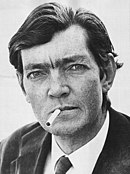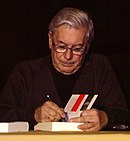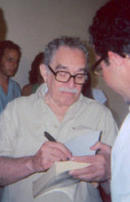Latin American Boom
The Latin American Boom (Boom Latinoamericano) is the name applied to a period during the 1960s and 1970s when the work of a group of relatively young Latin American novelists became widely circulated in Europe and throughout the world. This sudden success (hence the movement's name) came in large part thanks to the fact that these authors' works were among the first Latin American novels to be published in Europe, by publishing houses such as Barcelona's avant-garde Seix Barral in Spain.[1] Indeed, Frederick M. Nunn writes that "Latin American novelists became world famous through their writing and their advocacy of political and social action, and because many of them had the good fortune to reach markets and audiences beyond Latin America through translation and travel--and sometimes through exile."[2] Some of the Seix Barral-published novels include Mario Vargas Llosa's Pantaleon y las visitadoras (1973), La ciudad y los perros and Manuel Puig's La traicion de Rita Hayworth (1971). [3]
"It is no exaggeration," Gerald Martin writes, "to state that if the Southern continent was known for two things above all others in the 1960s, these were, fist and foremost, the Cuban Revolution and its impact both on Latin America and the Third World generally, and secondly, the boom in Latin American fiction, whose rise and fall coincided with the rise and fall of liberal perceptions of Cuba between 1959 and 1971." [4]
Background
The rise of Latin American literature starts with the writings of Jose Marti, Ruben Darío and José Asunción Silva's modernism stepping aside from the European literary canon. However, European modernist writers like James Joyce have influenced the writers of the Boom, as have the Latin American writers of the Vanguardia movement.[5]
A radical shift in the way in which history and literature were conceived, interpreted, and written produced a change in the self perception of Spanish American novelists between 1950 and 1975. The development of the cities, the coming of age of a large middle class, the Cuban Revolution, the Alliance for Progress, an increase in communication between the countries of Latin America, the greater importance of the mass media, and a greater attention to Latin America from Europe and the United States, contributed to this change. The most important political events of the period were the Cuban Revolution in 1959 and the Chilean coup d´état in 1973, but there were also others that affected writing, as they generated explanations, testimonies, or served as a troubling background:
- The fall of General Perón in Argentina
- The protracted violent struggle of the urban guerrillas, brutally repressed in Argentina and Uruguay, and the unending violence in Colombia. [6]
The greater attention paid to Spanish American novelists and their international success in the 1960´s, a phenomenon that was called the Boom, affected all writers and readers who lived through this important event. A number of gifted novelists, but what mainly brought writers together and focused the attention of the world on Spanish America was the triumph of the Cuban Revolution in 1959, which promised a new age. The period of euphoria can be considered closed when in 1971 the Cuban government hardened its party line and the poet Heberto Padilla was forced to reject in a public document his so-called decadent and deviant views. The furor over Padilla´s case brought to an end the affinity between Spanish American intellectuals and the Cuban inspirational myth. [7]
Influences on the Latin American Boom
The history of the Spanish American novel from 1950 to 1975 saw a change in the standing of the native writers, who went from marginal and tolerated - the center having been earlier Paris and New York- to central and celebrated. Simultaneously there was a shift from the novel as history to history as a novel, from the power of facts to the preeminence of the world. [citation needed]
In general -and considering there are many countries and hundreds of important authors- at the start of the period Realism prevails, with novels tinged by an existentialist pessimism, with well-rounded characters lamenting their destinies, and a straightforward narrative line. In the 1960´s, language loosens up, gets hip, pop, streetwise, characters are much more complex, and the chronology becomes intricate, making of the reader an active participant in the deciphering of the text. Late in the period the political adventure goes sour, while the linguistic sophistication reaches a new height, and novelists turn more to a reflection on their own writing, a fiction on fiction or metafiction, while characters and story lines show the corrosive power of a Postmodern society, where all is equally available and insignificant.[8]
The major representatives of the Latin American Boom adopted the avant-garde strategy of proclaiming a new beginning and declaring most of the traditional masters obsolete. Carlos Fuentes in his influential study "La nueva novela hispanoamericana", argued convincingly that the Spanish American novel had been devoured by the jungle, the mountains, the rivers, in short by a descriptive passion for Spanish American nature. It is also recognized that what was promoted in the 1960´s in Spanish America as a distinct move away from tradition can be traced back to the experimentation of the avant-garde movements in the early part of the century.{[fact}}
The story of the Boom could start chronologically with Miguel Angel Asturias´s El Señor Presidente (published in 1946, but started in 1922). Other starting points could be Sabato´s "El túnel" (1948). or Onetti´s "El Pozo" (1939). Or go even farther back, to the vanguardist movements of the 1920´s. However, the wirters of the Boom declared themselves orphaned and without any autochthonous model, caught between their admiration for Proust, Joyce, Mann, Sartre and other European writers and their need to have a Spanish American voice, even if they rejected the most respected Spanish American writers "Indigenistas", Criollistas, and Mundonovistas. [9]
Major representatives
Who is and who is not to be included in the Boom has been widely debated and never settled. On the other hand, a few writers exerted wide and undisputed influence. While the names of many other writers may be added to the list, the following may not be omitted:

was born in Belgium in 1914 and died in Paris, France in 1985. He was influenced by Borges his works are Final del Juego, Bestiario, Las Armas Secretas, Todos los juegos el fuego, the storytellers of Rayuela and the Premios, Winners in 1960, novels like: Historias de Cronopios y de famas and another famous novel is Vuelta al día en 80 mundos. His most important work was the novel Rayuela.

not only wrote some of the most important novels of the period, but was also an indefatigable and brilliant publicist of Spanish America.[citation needed]

shot to fame with his novel La ciudad y los perros. In this novel he gathers hate, and violence, proper elements of a city. He also wrote La casa verde, Los Cachorros, Pantaleón y las visitadoras, Conversación en la Catedral, La tía Julia y el escribidor. The characteristics of his novels were a complex tecnique where there are overlapping monologues, dialogues, actions, different spaces and time. He gives very vague descriptions with an implacable and hard style of writting. One of his most important dialogues of this famous Peruvian novelist is called Día Domingo. and especially

However, in the light of these authors' success, the work of a previous generation of writers also gained access to a new and expanded public, such as Jorge Luis Borges, Miguel Ángel Asturias, and Alejo Carpentier.
Jorge Luis Borges (1898-1986), whose most famous works include El Aleph, Historia Universal de la Infamia, and Ficciones wrote stories that he described as fiction or symbolic stories, with real or imaginary characters which move between the reality, magic and satiric scenes.
As well as being a publishing phenomenon, the Boom introduced a series of novel aesthetic and stylistic features to world literature. Though the various Boom authors often differ very much from each other, and should not be regarded strictly as a school or movement, they have come to be associated above all with so-called magical realism.[citation needed]
Other figures
Octavio Paz and Juan Rulfo. Juan Rulfo, the author of two books, only one of them a novel, was the acknowledged master incorporated a posteriori; a writer who balances social concern, verbal experimentation and unique style. José Donoso.
- Precursors of the Boom
- Jorge Luis Borges - Argentina
- Alejo Carpentier - Cuba
- José Lezama Lima - Cuba
- Juan Carlos Onetti - Uruguay
- Juan Rulfo - México
- Writers also associated with the Boom
- Augusto Roa Bastos - Paraguay
- Manuel Puig - Argentina
- Salvador Garmendiä - Venezuela
- David Viñas - Argentina
- Carlos Martinez Moreno - Uruguay
- Mario Benedetti - Uruguay
- Vicente Leñero - México
- Rosario Castellanos - México
- Jorge Edwards - Chile
- Enrique Lafourcade - Chile
- Augusto Monterroso - Guatemala
- Jorge Ibargüengoitia - México
- Adriano González León - Venezuela
Hallmarks
Magical realism
The awestruck writings of the Chroniclers of the Indies and their sense of being in another world, conquering strange new lands unparalleled outside of chivalric romances, became a cultural touchstone for the people of Latin America. From these fantastical tales developed a new aesthetic, which matured into magical realism and (as conceived by Alejo Carpentier) marvelous realism or lo real maravilloso. According to this aesthetic, unreal things are treated as if realistic and mundane, and mundane things as if unreal. Plots, while often based on real experiences, incorporate strange, fantastic, and legendary elements, mythical peoples, speculative settings, and characters who, while plausible, could also be unreal, and combine the true, the imaginary, and the nonexistent in such a way that they are difficult to separate.
Comparing a novel written before the Latin American Boom to one written under its influence, the former is likely to strive for authenticity and reality, depicting a plain and somber reality, while the latter strives to show multiple facets of each character and each place. Boom literature breaks down the barriers between the fantastical and the mundane, transforming this mixture into a new reality. Of the Boom writers, Gabriel Garcia Marquez is most closely associated with the use of magical realism; indeed, he is credited with bringing it "into vogue" after the publishing of One Hundred Years of Solitude in 1966.[10]
Historical fiction is another characteristic of the novels of the Boom period.[11]
Publishing Latin American Boom novelists
It should not surprise anyone that most novels that feature in the Latin American Boom were published in Havana, Mexico City, Buenos Aires, Montevideo, Asunción or Santiago. Those have been the sites of important publishing houses and strong centers of cultural innovation. [12]
- Buenos Aires and Montevideo had their own local stars, such as Murena and Mallea, Bio Casares or Viñas, but some of their works do not travel well;[citation needed]
- Santiago in Chile, is presided by the criticism of Alone, while the older generation of Benjamín Subercaseaux, Eduardo Barrios, Marta Brunet, and Manuel Rojas is quietly superseded by José Donoso. Other writers, such as Enrique Lafourcade, have a large national readership.
- Cuba is a lively cultural center, first with the group of Orígenes, and then with Lunes de Revolución. [13]
- In Colombia the rural novels of Caballero Calderon are displaced by García Márquez who is followed by Alvarez Gardeazábal. [14]
- Mexico continues a tradition of strong regional writers and diverse schools of writing, from Yañez to Sainz, with novelists such as Luis Spota or Sergio Fernández, the first a popular, the other a refined, writer, both better known in Mexico than abroad.[15]
It should be noted, however, that this period saw the publishing of Boom novels in Barcelona, reflecting the new interest of Spanish publishing houses in the Spanish American market. However, as Alejandro Herrero-Olaizola notes, the revenue generated by the publishing of these novels gave a boost to the Spanish economy, even as the works were subjected to Franco's censors.[16] A crucial figure "in the promotion of Latin American literature in Spain," (and elsewhere) was the "super-agent" Carmen Balcells, whom Llosa reffered to as "The Big Mama of the Latin American novel."[17]
Impact
The Boom changed the way Latin American culture was viewed around the world. The commercial success of the boom writers had the effect of elevating them almost to rock star status in Latin America.[18]
Post-Boom
Since the 1980s it has become common to speak of Post-Boom writers, most of whom were born during the 1940s, 1950s, and 1960s. The Post-Boom is distinct from the Boom in various respects, most notably in the presence of female authors such as Isabel Allende, Luisa Valenzuela and Elena Poniatowska.[19]
Critique
A common criticism of the Boom is that it is too experimental and has a "tendency toward elitism" [20] Also oft criticized is the Boom's emphasis on masculinity, both in the fact that all of the movement's representatives were male and the treatment of female characters within the novels.
Chronology
Some of the major publications and landmarks of the Boom and its precursors:
- 1949: Alejo Carpentier, El reino de este mundo
- 1949: Miguel Angel Asturias, Hombres de maíz
- 1955: Juan Rulfo, Pedro Páramo
- 1962: Carlos Fuentes, La muerte de Artemio Cruz
- 1963: Mario Vargas Llosa, La ciudad y los perros
- 1963: Julio Cortázar, Rayuela
- 1964: Clarice Lispector, A paixão segundo G.H.
- 1966: Emir Rodríguez Monegal founds Mundo Nuevo (1966–1971) in Paris
- 1966: José Lezama Lima, Paradiso
- 1967: Miguel Angel Asturias awarded the Nobel Prize in literature
- 1967: Gabriel García Márquez, Cien años de soledad
- 1967: Jorge Amado, Dona Flor e Seus Dois Maridos
- 1967: Guillermo Cabrera Infante, Tres tristes tigres
- 1967: Severo Sarduy, From Cuba with a Song / De donde son los cantantes
- 1970: José Donoso, El obsceno pájaro de la noche
- 1974: Augusto Roa Bastos, Yo, el Supremo (I, the Supreme)
- 1982: Gabriel García Márquez awarded the Nobel Prize in literature
See also
Footnotes
- ^ Herrero-Olaizola, p. xxi
- ^ Nunn, 4.
- ^ Herrero-Olaizola, 65-67; 163
- ^ Martin, 53. (from:Martin, Gerald. "Boom, Yes; 'New' Novel, No: Further Reflections on the Optical Illusions of the 1960s in Latin America." Bulletin of Latin American Research. Vol. 3, No. 2. (1984) 53-63.)
- ^ Coonrod Martinez 2001, p. 2-3, 119
- ^ Pope 226
- ^ Pope 229
- ^ information of Randolph D. Pope from Echevarría, González Roberto. "The Cambridge History of Latin America, Volume 2: The Twentieth Century" Cambridge University Press. 1996, page??
- ^ Pope 229
- ^ Ocasio, 92
- ^ Nunn, 73
- ^ Pope 230
- ^ Pope 230
- ^ Pope 230
- ^ information of Randolph D. Pope from Echevarría, González Roberto. "The Cambridge History of Latin America, Volume 2: The Twentieth Century" Cambridge University Press. 1996, page number??
- ^ Herrero-Olaizola, xxi
- ^ Herrero-Olaizola, 173-74
- ^ Martin, 54
- ^ Shaw, 10,22-23.
- ^ Shaw, 27-28
References
- Coleman, Alexander. "Guide to the Latin American Boom." Review of José Donoso's The Boom In Spanish American Literature: A Personal History (New York: Colombia University Press). Boston Review (Fall 1977).
- Coonrod Martinez, Elizabeth (2001). Before the Boom: Latin American Revolutionary Novels of the 1920s. New York: University Press of America.
{{cite book}}: Cite has empty unknown parameter:|coauthors=(help)
- Echevarría, González Roberto. "The Cambridge History of Latin America, Volume 2: The Twentieth Century" Cambridge: Cambridge University Press, 1996.
- Herrero-Olaizola, Alejandro. The Censorship Files: Latin American Writers and Franco's Spain. Albany: SUNY Press, 2007.
- Levinson, Brett. The Ends of Literature: The Latin American "Boom" in the Neoliberal Marketplace Stanford: Stanford University Press, 2001.
- Nunn, Frederick M. Collisions With History: Latin American Fiction and Social Science from El Boom to the New World Order. Athens, Ohio: Ohio University Press, 2001.
- Ocasio, Rafael. Literature of Latin America. Westport, CT: Greenwood Press, 2004.
- Shaw, Donald L. (1998). The Post-Boom in Spanish American Fiction. Albany: SUNY Press.
